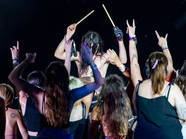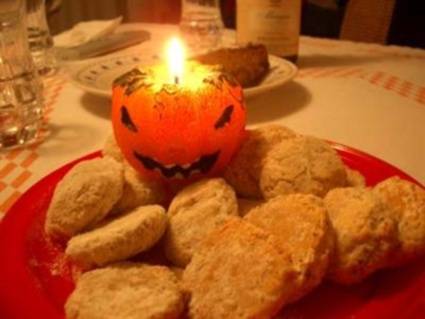Halloween all’italiana
Just a few decades ago Halloween in Italy was merely the name of an American holiday, a sort of Carnevale.
Little by little Halloween’s popularity has grown, probably due to the influence of American movies and the arrival of American fast food chains like McDonald’s, and it has become a real celebrated holiday, even though it doesn’t have a real connection to Italy, apart from the fact that All Saints Day (November 1st) is celebrated here – a holiday when people typically have the day off. The 2nd of November is the day dedicated to the remembrance of the dead, a holy day during which people visit cemeteries bringing flowers and candles to dead relatives and friends – a day dedicated to special celebrations by the Church as well. In some parts of Italy children find presents brought during the night by the dead. This day of remembrance can be found in other parts of the world: for example, in Japan in August there is the “Obon Festival”, one of the most important traditions for Japanese people who pray for the peace of the souls of their ancestors during this time. The Japanese believe that their ancestors’ spirits come back to their homes to be reunited with their family during Obon.
In all the Italian regions in the days between October 31st and the day of Saint Martin (November 11th) there has been – from time immemorial – the folkloristic custom to celebrate the juxtaposition of life and death with traditions expressing the strong link between those still alive and those who are no longer on this earth. All these customs have the expression of the strong link with life and with families in common, and the fact that these traditions often involve children, is a clear way of marking the idea of continuity, of regeneration, of hope.
Until the first half of the 20th Century, this period of the year was the only occasion for children to receive presents, toys, sweets, that were usually brought by “the dead”. Over time new traditions arrived, such as Christmas and the Epiphany, which became more widespread and more popular among the younger generations. Even though I’m in my forties, I still remember when, as a child in Sicily, my parents told me to behave well, so the good souls of the dead would bring me many presents. On the night between the 1st and the 2nd of November I went to bed hoping that the dead relatives would remember me, while my parents and other members of my traditional Sicilian family were hiding toys and sweets in secret places around the house. There was a sort of rigmarole sang by Sicilian children in dialect: “Armi santi, armi santi, jo sugnu unu e vuautri siti tanti. Mentri sugnu ‘nta stu munnu di guai, cosi di morti mittitimminni assai.” (Holy souls, holy souls, I am one, and you are many. While I am in this world of troubles, bring me lots of presents from dead people). And the morning after, once I had found the presents, the whole family prepared to visit the cemetery: it was not a sad day, after all there was the joy of the “contact” never lost, going beyond death, the consciousness that there was a strong connection between the worlds of the dead and the living, two world united by the power of love.
Apart from my own memories, in every Italian region there are celebrations to remember the dead. The tradition of the pumpkin is not only typically Anglo-Saxon: in fact it can also be found in the Italian tradition. In Veneto, for example, pumpkins are emptied, painted and a candle symbolizing resurrection is pit inside them. In Friuli, especially in the area near Pordenone, the pumpkins prepared in this way are put along the roads to light the path for the dead. In Puglia every family adorns their own pumpkin and puts it on display in the windows of their house. In Lombardia pumpkins are filled with wine, so that the dead can drink it during the night between the 31st October and the 1st of November, before returning to the kingdom of afterlife.
The traditions also include typical dishes prepared during this time and handed down from generation to generation. In Romagna, a region well known for its cooking, the “piada dei morti”, a very tasty round flatbread filled with nuts, almonds, raisins and the red wine of Romagna, the Sangiovese, is prepared. Another sweet prepared during this time in Romagna is the “fava dei morti”, a little biscuit made of almonds.
In Sicily the typical dishes for this time of year is the “pupi ‘i zuccuru”, a sweet bread shaped like little dolls, and the “dead bones”, biscuits having the shape of bones that are particularly hard to bite. Very peculiar is the “frutta marturana”, which is marzipan shaped into real fruits with an inviting scent.
The rituals all over Italy are almost the same: in Puglia the families prepare the “cavazette di murte” (socks of the dead) and, during the night the dead, relatives fill them with special sweets. In Sicily, near Siracusa, children prepare the table for the dead and leave a shoe to be filled with presents and sweets. The “trick or treat” question seems another tradition in common between Italy and the USA. In fact, in Abruzzo there was the habit of going from house to house asking for offers for the souls of the dead and generally sweets and dried fruits were handed out. In general these are all traditions that give an almost friendly idea of death: the dead bring presents, walk for a night in the roads of villages or cities, enter into the house to have a dinner during this special night, and are felt closer than ever.
All these Italian traditions are unfortunately disappearing, substituted by Halloween, a holiday far from Italy, even while sharing characteristics in common with these traditions. Why not bring back our important past customs, instead of adopting those of other countries, just to follow foreign fashions that lack our soul?










































i-Italy
Facebook
Google+
This work may not be reproduced, in whole or in part, without prior written permission.
Questo lavoro non può essere riprodotto, in tutto o in parte, senza permesso scritto.